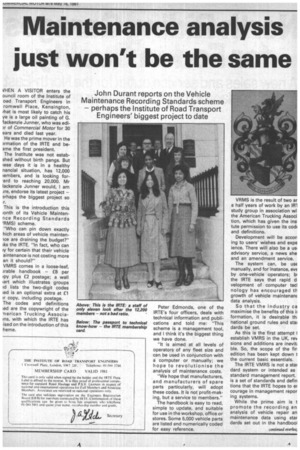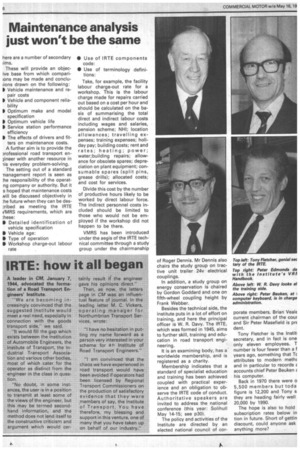Maintenance analysis just won't be the same
Page 37

Page 38

If you've noticed an error in this article please click here to report it so we can fix it.
John Durant reports on the Vehicle Maintenance Recording Standards scheme — perhaps the Institute of Road Transport Engineers' biggest project to date
VHEN A VISITOR enters the ouncil room of the Institute of oad Transport Engineers in romwell Place, Kensington, that is most likely to catch his ye is a large oil painting of G. lackenzie Junner, who was edi)1of Commercial Motor for 30 ears and died last year.
He was the prime mover in the rrmation of the IRTE and beme the first president.
The Institute was not estabshed without birth pangs. But tese days it is in a healthy nancial situation, has 12,000 tembers, and is looking for'ard to reaching 20,000. Mr lackenzie Junner would, I am rre, endorse its latest project — h aps the biggest project so r.
This is the introduction this ionth of its Vehicle Maintennce Recording Standards 'RMS) scheme.
"Who can pin down exactly hich areas of vehicle maintenice are draining the budget?" tks the IRTE. "In fact, who can iy for certain that their vehicle aintenance is not costing more an it should?"
VMRS comes in a loose-leaf, rrable handbook — £8 per Ipy plus £2 postage; a wall 'art which illustrates groups Id lists the two-digit codes ;ed is an optional extra at £1 tr copy, including postage. The codes and definitions ;ed are the copywright of the -nerican Trucking Associams, with which the IRTE has ised on the introduction of this heme.
Peter Edmonds, one of the IRTE's four officers, deals with technical information and publications and told me: "This scheme is a management tool, and I think it's the biggest thing we have done.
"It is aimed at all levels of operators of any fleet size and can be used in conjunction with a computer or manually; we hope to revolutionise the analysis of maintenance costs.
"We hope that manufacturers, and manufacturers of spare parts particularly, will adopt these codes. It is not profit-making, but a service to members."
The handbook is easy to read, simple to update, and suitable for use in the workshop, office or stores. Some 5,000 vehicle parts are listed and numerically coded for easy reference.
VRMS is the result of two ar a half years of work by an IR1 study group in association wj the American Trucking Associ tion, which has given the ins. tute permission to use its codi and definitions.
Development will be accor ing to users' wishes and expe ience. There will also be a us, advisory service, a news she and an amendment service.
The system can, be USE manually, and for instance, evE by one-vehicle operators; bi the IRTE says that rapid d velopment of computer tecl nology has encouraged th growth of vehicle maintenanc data analysis.
So that the industry ca maximise the benefits of this ii formation, it is desirable th. national ground rules and stai dards be set.
As this is the first attempt I establish VMRS in the UK, rev sions and additions are inevit; ble. So, the scope of the fir: edition has been kept down t the current basic essentials.
The IRTE VMRS is not a star dard system or intended as standard management report. is a set of standards and defin tions that the IRTE hopes to er courage in management repor ing systems.
While the prime aim is t promote the recording an analysis of vehicle repair an maintenance data using star dards set out in the handbool here are a number of secondary urns.
These will provide an objecive base from which compari;ons may be made and conclu;ions drawn on the following: 10 Vehicle maintenance and re
pair costs
10 Vehicle and component reliability D Optimum make and model specification
0 Optimum vehicle life
D Service station performance efficiency D The effects of drivers and fit
ters on maintenance costs.
A further aim is to provide the )rofessional road transport enineer with another resource in 115 everyday problem-solving.
The setting out of a standard nanagement report is seen as he responsibility of the operatng company or authority. But it s hoped that maintenance costs Nill be discussed objectively in :he future when they can be desribed as meeting the IRTE i/MRS requirements, which are :hese:
ID Detailed identification of vehicle specification I Vehicle age: II Type of operation 11 Workshop charge-out labour rate
• Use of IRTE components code: • Use of terminology definitions: Take, for example, the facility labour charge-out rate for a workshop. This is the labour charge made for repairs carried out based on a cost per hour and should be calculated on the basis of summarising the total direct and indirect labour costs including wages and salaries, pension scheme; NHI; location allowances; travelling expenses; training expenses; holiday pay; building costs; rent and rates; heating; power; water:building repairs; allowance for obsolete spares; depreciation on plant equipment; consumable spares (split pins, grease drills); allocated costs; and cost for services.
Divide this cost by the number of productive hours likely to be worked by direct labour force. The indirect personnel costs included should be limited to those who would not be employed if the workshop did not happen to be there.
VMRS has been introduced under the aegis of the IRTE technical committee through a study group under the chairmanship of Roger Dennis. Mr Dennis also chairs the study group on tractive unit trailer 24v electrical couplings.
In addition, a study group on energy conservation is chaired by Gordon Goddard and one on fifth-wheel coupling height by Frank Webber.
Besides the technical side, the institute puts in a lot of effort on training, and here the principal officer is W. R. Davy. The IRTE, which was formed in 1945, aims to further skill, training and education in road transport engineering.
It is an examining body, has a worldwide membership, and is registered as a charity.
Membership indicates that a standard of specialist education and training has been achieved coupled with practical experience and an obligation to observe the IRTE code of conduct. Authoritative speakers are invited to address the national conference (this year: Solihull May 14-15; see p30).
The policy and activities of the Institute are directed by an elected national council of cor
porate members. Brian VealE current chairman of the cour and Sir Peter Masefield is prE dent.
Tony Fletcher is the Instit secretary, and in fact is one only eleven employees. T number is four fewer than a f years ago, something that Tc attributes to modern meth( and in particular to records E accounts chief Peter Beuken his computer.
Back in 1970 there were o 5,500 members but toda figure is 12,200 and Tony s they are heading fairly well 20,000 by 1990.
The hope is also to hold subscription rates below in tion in future. Short of gettin discount, could anyone ask anything more?




































































































































